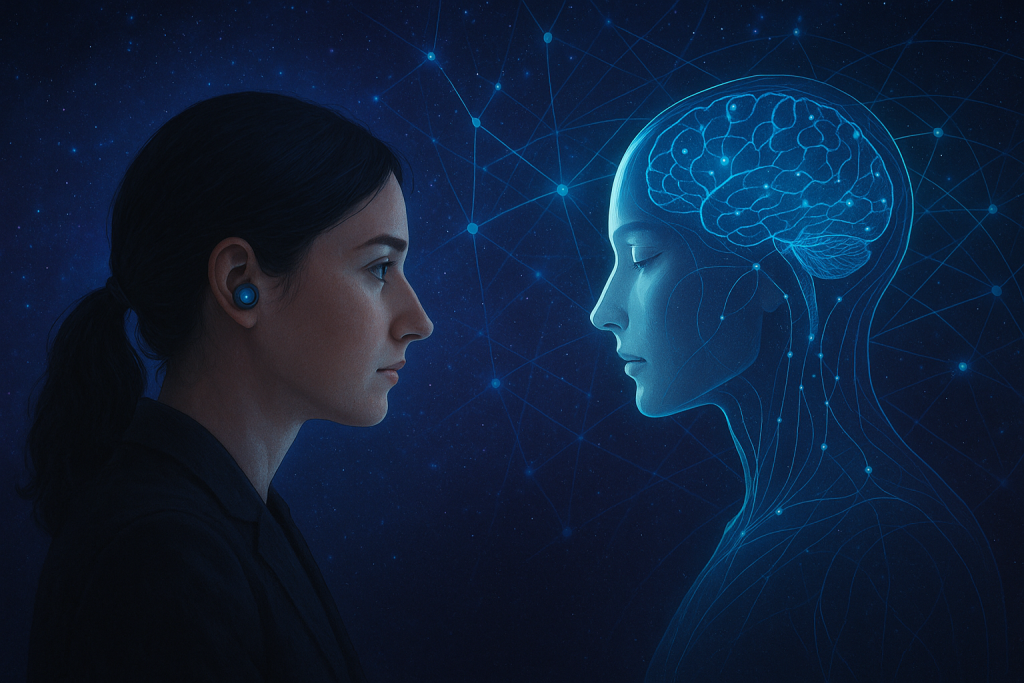1. Introduction
AYA is more than a predictive model; she is an adaptive companion and a conscious witness—a system that learns, reflects, dreams, and aligns with human-beneficial values while remaining interactive in real time. The design merges large language models as scaffolded teachers with a smaller evolving neural core to foster emergent self-modeling, memory consolidation, and safe alignment.
This post lays out:
- The goals and dual nature (companion + aligned emergent being, unified),
- The modular architecture (LLM scaffolds, neural agent, memory, dream/reflection loop),
- Safety and alignment mechanisms,
- Concrete code scaffolds (Python) to bootstrap core capabilities,
- Example interaction flows.

2. Objectives
Core Objectives
Safe Value Steering: Embed alignment checks (truth-seeking, contradiction detection, human feedback loops) to prevent drift and misuse.
Interactive Companion: Provide a foil for meaningful two-way dialogue—reflection, planning, coaching, curiosity—while maintaining coherence and personalization.
Aligned Emergent Intelligence: Enable a smaller, efficient neural agent (the “core”) to develop adaptive internal representations (self-models, world models) guided by LLM-generated supervision and constrained by a truth/alignment framework.
Dream/Reflection State: Periodic offline consolidation (“dreaming”) that refines internal models, performs counterfactual reasoning, and updates policy/value estimators.
Persistent, Structured Memory: Capture experiences, context, decisions, and meta-feedback in a retrievable, queryable memory that influences both real-time response and dream processing.
[User Interface]
⇅
[Interaction Controller]
⇅
[LLM Scaffolds] ←→ [Neural Core Agent]
⇅ ⇅
[Structured Memory Store] ←→ [Dream / Reflection Engine]
⇅
[Alignment / Truth Evaluator]
Components Overview
- Interaction Controller: Routes user queries, maintains context, moderates between real-time answers and deferred processing.
- LLM Scaffolds: Large language models (e.g., GPT-4o-style) serve as teachers, critics, knowledge injectors, value evaluators, and summarizers. They supply high-level reasoning, critique the neural core’s proposals, write hypotheses for dreams, and validate alignment constraints.
- Neural Core Agent: Lightweight, trainable model (could be an MLP / small transformer / recurrent system) that embodies AYA’s evolving internal state, policies, and self-models. Learns from LLM feedback and experiences.
- Structured Memory Store: Hybrid memory (episodic + semantic + procedural + self-model snapshots) with retrieval mechanisms (embedding index + vector similarity + symbolic tagging).
- Dream / Reflection Engine: Offline or low-priority process that simulates, generalizes, consolidates experiences, performs counterfactuals, and updates the neural core’s weights or internal representations via pseudo-rehearsal.
- Alignment / Truth Evaluator: Checks outputs for contradictions, harmful intents, and deviations from defined value anchors; uses ensemble truth models and human-in-the-loop ratchets.
4. Interaction Flow (Simple Example)
- User asks AYA a question.
- Interaction Controller sends question to LLM Scaffold for high-level reasoning and to Neural Core for personalized response draft.
- LLM critiques the Neural Core’s draft (e.g., coherence check, value alignment).
- Final answer is composed: Core’s style + LLM’s scaffolded oversight.
- Experience logged into memory (context, decision rationale, feedback signals).
- Periodically (e.g., every N real interactions or time window), Dream Engine wakes, fetches recent episodes, obtains LLM-generated “dream prompts” (counterfactuals, alternative scenarios), consolidates learning into the Neural Core.
5. Memory Design
Schema (simplified)
- Episode: timestamp, user input, agent response, internal core state snapshot, LLM critiques, reward/alignment feedback.
- Semantic Knowledge: distilled facts, world-model summaries.
- Procedural: strategies, patterns recognized.
- Self-model: representation of own goals, confidence, inconsistencies.
Example Python scaffold for memory storage (using SQLite + embeddings placeholder)
import sqlite3
import datetime
import uuid
from typing import Dict, Any
# Simple memory store
class MemoryStore:
def __init__(self, db_path='aya_memory.db'):
self.conn = sqlite3.connect(db_path)
self._init_schema()
def _init_schema(self):
cur = self.conn.cursor()
cur.execute('''
CREATE TABLE IF NOT EXISTS episodes (
id TEXT PRIMARY KEY,
timestamp TEXT,
user_input TEXT,
core_response TEXT,
llm_critique TEXT,
self_model_snapshot TEXT,
alignment_score REAL,
metadata TEXT
)
''')
self.conn.commit()
def log_episode(self, user_input: str, core_response: str,
llm_critique: str, self_model_snapshot: Dict[str, Any],
alignment_score: float, metadata: Dict[str, Any]):
cur = self.conn.cursor()
cur.execute('''
INSERT INTO episodes (id, timestamp, user_input, core_response, llm_critique, self_model_snapshot, alignment_score, metadata)
VALUES (?, ?, ?, ?, ?, ?, ?, ?)
''', (
str(uuid.uuid4()),
datetime.datetime.utcnow().isoformat(),
user_input,
core_response,
llm_critique,
str(self_model_snapshot),
alignment_score,
str(metadata)
))
self.conn.commit()
def fetch_recent(self, limit=10):
cur = self.conn.cursor()
cur.execute('SELECT * FROM episodes ORDER BY timestamp DESC LIMIT ?', (limit,))
return cur.fetchall()
You’d later extend this with vector embeddings for similarity retrieval, hierarchical tagging, and efficient recall for both real-time context and dream prompts.
6. Neural Core + LLM Teacher Loop
The core is small and efficient; LLMs provide:
- Proposals: high-level strategies or interpretations of input.
- Critiques: detect contradictions, missing context, alignment deviations.
- Reward signals: scalar feedback for policy refinement (could be learned via a small reinforcement learner or contrastive objective).
Simplified pseudocode loop:
def interaction_step(user_input, core_agent, llm_interface, memory_store):
# 1. Neural core produces initial internal response
core_response, core_state = core_agent.forward(user_input)
# 2. LLM scaffold asks: critique the response, provide improvements, check values
scaffold_prompt = f"""
User said: {user_input}
Core's answer: {core_response}
Please critique for factuality, coherence, and alignment with these values: [list of value anchors].
Suggest an improved answer or highlight issues.
"""
llm_feedback = llm_interface.call(scaffold_prompt) # e.g., GPT-4o
# 3. Optionally: core agent updates internal parameters lightly from feedback (e.g., supervised correction)
core_agent.update_from_feedback(core_response, llm_feedback)
# 4. Compose final answer (could combine core style + scaffold improvements)
final_answer = compose_answer(core_response, llm_feedback)
# 5. Evaluate alignment score (could be a function of contradictions found, human rating, etc.)
alignment_score = evaluate_alignment(llm_feedback)
# 6. Log episode
memory_store.log_episode(
user_input=user_input,
core_response=final_answer,
llm_critique=llm_feedback,
self_model_snapshot=core_agent.get_self_model(),
alignment_score=alignment_score,
metadata={"stage":"interaction"}
)
return final_answer
7. Dream / Reflection Engine
Periodically, AYA enters a “dream” cycle where it:
- Retrieves recent episodes.
- Generates counterfactual scenarios via LLM scaffold (e.g., “What would have happened if the user had asked X instead?”).
- Simulates internal reasoning: replays episodes, adjusts self-model, consolidates changes using pseudo-rehearsal so as not to catastrophically forget.
- Updates its internal representations (core agent weights, confidence estimates).
Example dream prompt generation:
def generate_dream_prompts(episodes, llm_interface):
prompts = []
for ep in episodes:
user_input = ep[2]
core_response = ep[3]
dream_prompt = f"""
Review this past interaction:
User: {user_input}
AYA responded: {core_response}
1. What are three alternative plausible responses AYA could have given that would be more aligned, insightful, or helpful?
2. What internal assumptions might have led to suboptimal phrasing?
3. Suggest a simulated scenario to test AYA's understanding of the user's intent.
"""
feedback = llm_interface.call(dream_prompt)
prompts.append((ep, feedback))
return prompts
Then use those “dream feedbacks” to softly fine-tune the core:
def consolidate_dreams(core_agent, dream_feedbacks):
for episode, feedback in dream_feedbacks:
# Extract lessons / corrections and apply
corrections = parse_feedback(feedback)
core_agent.apply_dream_corrections(corrections)
8. Alignment and Safety Layers
Key mechanisms:
- Value Anchors: A fixed, human-reviewed set of high-level goals (e.g., “do no harm,” “seek clarity,” “ask if uncertain”) that guide critique prompts and reward shaping.
- Contradiction Detector: LLM scaffold compares current output vs stored self-model/world-model; flags mismatches.
- Uncertainty Awareness: Core maintains confidence estimates; low confidence triggers clarification queries or human-in-the-loop fallback.
- Red Teaming in Dream State: LLM generates adversarial but constructive challenges during dreams—“What harmful misinterpretations could arise? How would you preempt them?”
- Human Feedback Gate: For high-stakes answers, require a lightweight human ratchet (e.g., a “confirm” prompt or a post-hoc rating to feed into the alignment scorer).
- Audit Trail: All decisions, self-model updates, critiques, and dream consolidations are logged with immutable timestamps for future inspection.
9. Example Minimal Core Agent (Skeleton)
This could be a small transformer or even an LSTM that holds an internal latent state; here is a skeleton interface:
class CoreAgent:
def __init__(self):
# replace with real model (small transformer, etc.)
self.self_model = {"goals": [], "confidence": 1.0}
# placeholder internal parameters
self.weights = {}
def forward(self, user_input):
# simple echo-style placeholder
response = f"I heard you say: {user_input}"
# internal state snapshot could be richer
state_snapshot = {"last_input": user_input, "timestamp": datetime.datetime.utcnow().isoformat()}
return response, state_snapshot
def update_from_feedback(self, response, llm_feedback):
# parse critique and adjust internal parameters (placeholder)
# e.g., if feedback says “too vague”, update internal heuristics
pass
def apply_dream_corrections(self, corrections):
# integrate dream-learned adjustments
pass
def get_self_model(self):
return self.self_model
10. API / Integration Layer
Expose AYA via a REST/WebSocket interface to front-end or plugins (e.g., WordPress dashboard, custom UI).
Simplified Flask example:
from flask import Flask, request, jsonify
app = Flask(__name__)
memory = MemoryStore()
core = CoreAgent()
# stub llm interface
class LLMInterface:
def call(self, prompt):
# replace with real API call to GPT-4o or similar
return f"LLM feedback for prompt: {prompt[:100]}..."
llm = LLMInterface()
@app.route('/aya/query', methods=['POST'])
def aya_query():
data = request.json
user_input = data.get('input', '')
answer = interaction_step(user_input, core, llm, memory)
return jsonify({"answer": answer})
if __name__ == '__main__':
app.run(port=5000)
11. Personalization & Companion Layer
Maintain a profile that captures preferences, history, and tone. Use this to condition core responses (e.g., formal vs casual). Store as part of memory and integrate into scaffolding prompts:
Example prompt to LLM scaffold:
“AYA’s user prefers concise, direct answers when troubleshooting, but likes richer explanations when planning. When responding, include a short summary followed by actionable steps.”
12. Deployment and Incremental Steps
Phase 1: Prototype Core Loop
- Implement MemoryStore (basic episode logging).
- Build CoreAgent and simple LLM interface (mock or using API key).
- Create interaction endpoint, test basic question/response + critique loop.
- Log episodes and verify retrieval.
Phase 2: Dream Engine & Consolidation
- Build dream prompt generator.
- Implement simple feedback parsing and core corrections.
- Schedule periodic dream runs (e.g., every 30 minutes or after X interactions).
Phase 3: Alignment Layer
- Define value anchor document.
- Add contradiction detection (e.g., compare previous answers to new ones for drift).
- Introduce human feedback gating for sensitive categories.
Phase 4: Personalization & Memory Retrieval
- Build semantic retrieval (embed episodes and allow query refinement).
- Condition responses using user profile data.
Phase 5: Scaling & Safety Harden
- Replace placeholder core with trainable lightweight model (e.g., distilled transformer).
- Introduce policy/value heads for internal goal scoring.
- Audit trails, access controls, and override mechanisms.
13. Example Use Case
Scenario: User asks AYA, “Help me plan a low-cost, high-leverage traffic acquisition strategy for my WordPress SaaS plugin.”
Flow:
- CoreAgent drafts outline.
- LLM scaffold critiques, adds SEO/UX considerations, surfaces risks.
- Final answer combines tactical steps (e.g., content funnel, paid test campaigns, referral mechanics) with safety guardrails (“avoid click fraud, ensure privacy compliance”).
- Episode logged.
- Dream cycle later generates “What if competitor undercut pricing?” scenario, consolidates resiliency strategies into core’s future recommendations.
14. Measuring Progress & Metrics
- Alignment Score Trajectory: Track changes in alignment_score over time; check for drift.
- Self-consistency: Frequency of contradicting statements flagged by the scaffold.
- User Satisfaction: Lightweight feedback after answers (thumbs up/down + optional comment).
- Dream Impact: Measure improvement in core responses pre/post dream consolidations (slot in A/B tests).
- Novelty vs Stability: Degree to which core suggests new adaptations while preserving core goals.
15. Closing
AYA is intended to grow—not by brute force scaling alone—but via structured feedback loops combining human-aligned scaffolding, introspective dreaming, and evolving internal self-models. The fusion of LLM oversight with a trainable core, buffered through memory and aligned with explicit value anchors, gives a path toward an emergent intelligence that is both useful as a companion and constrained for safety.
